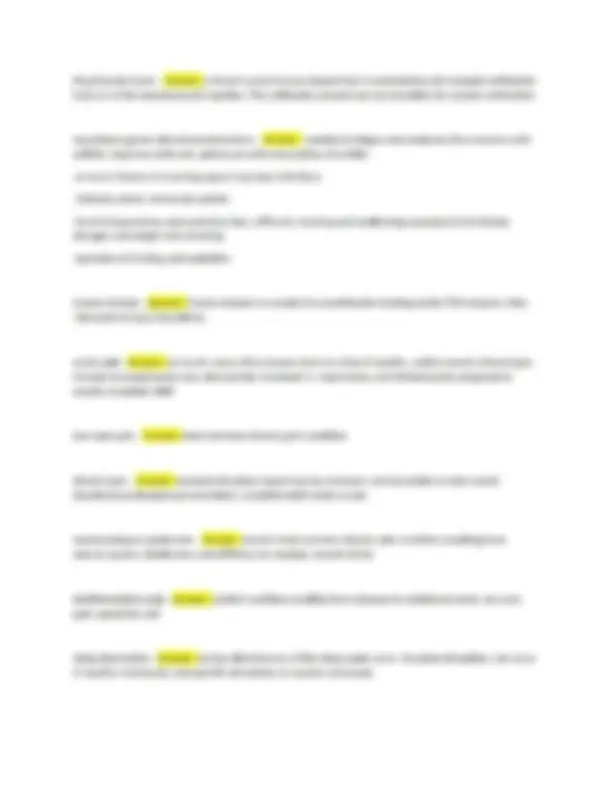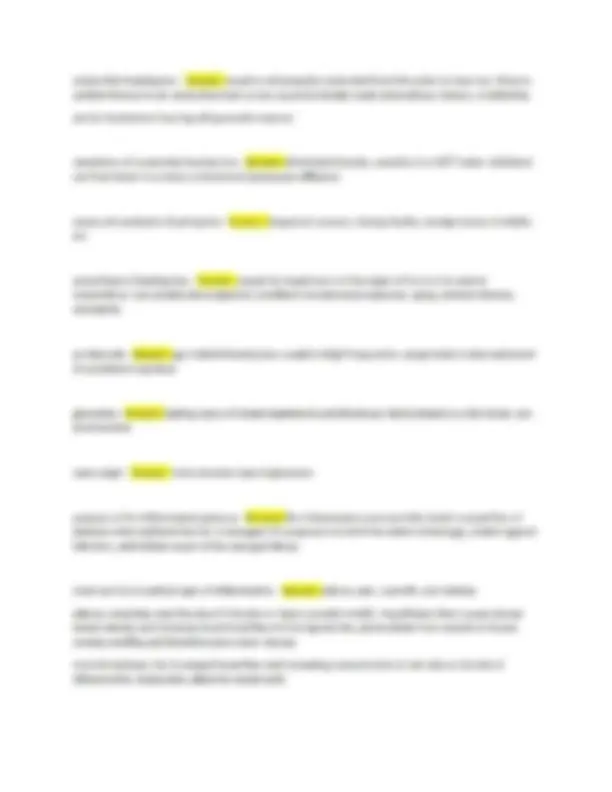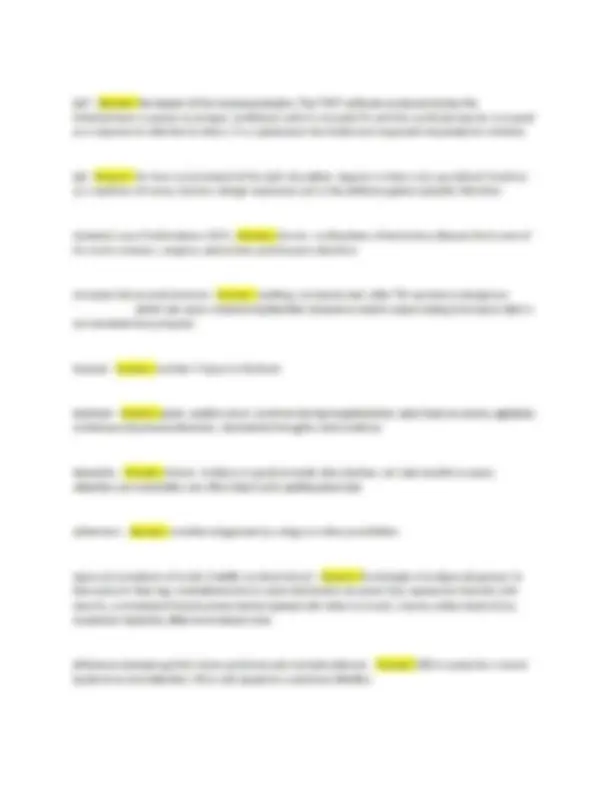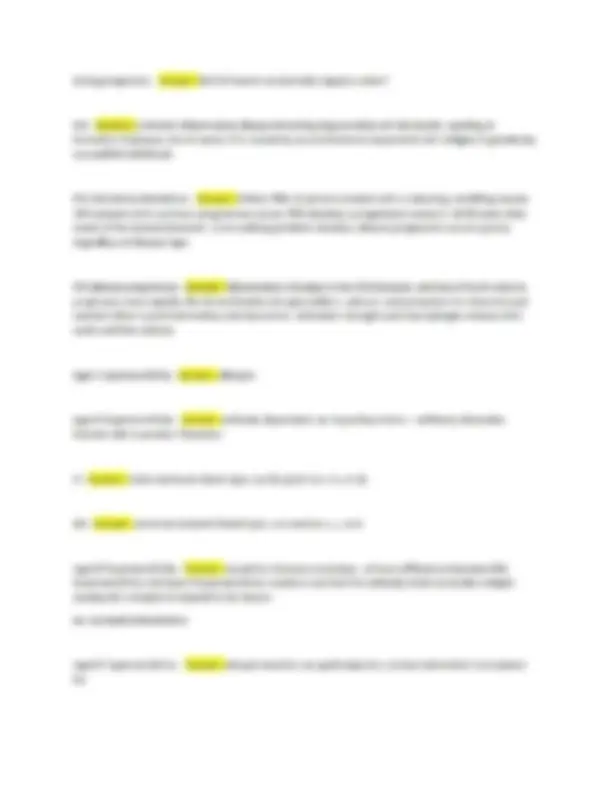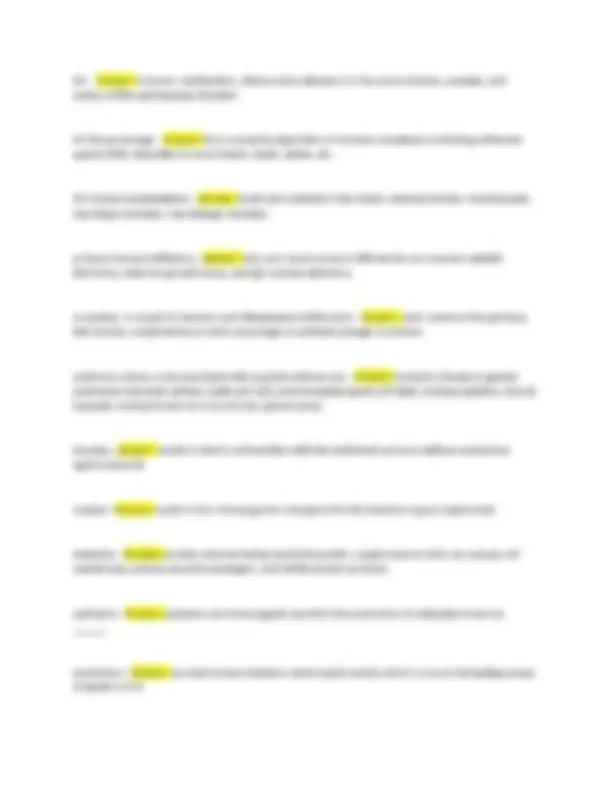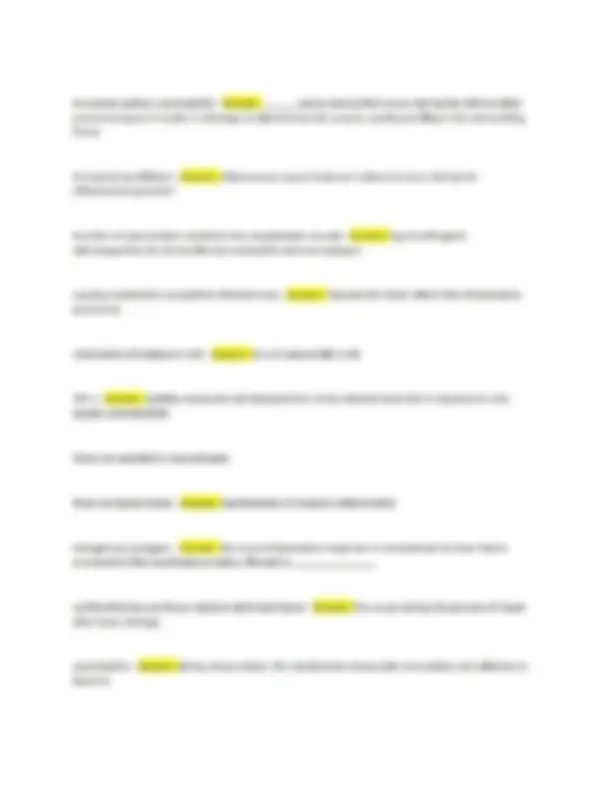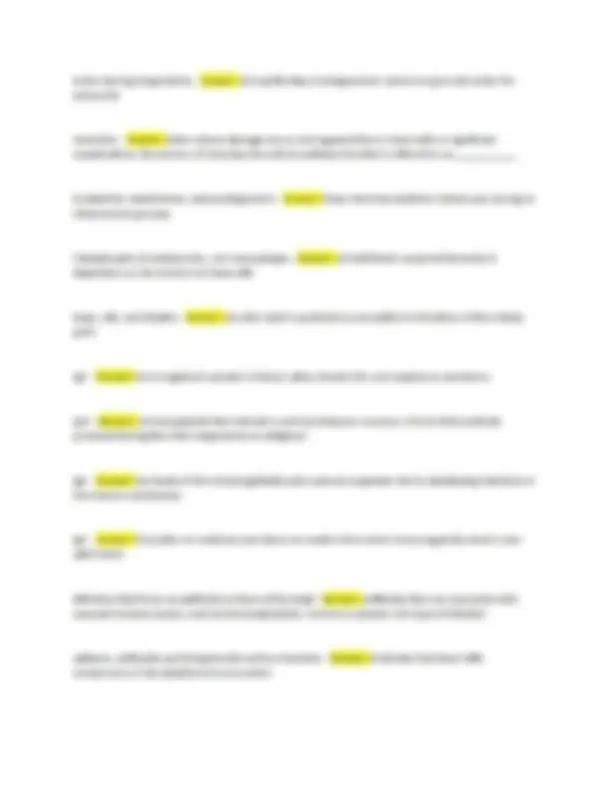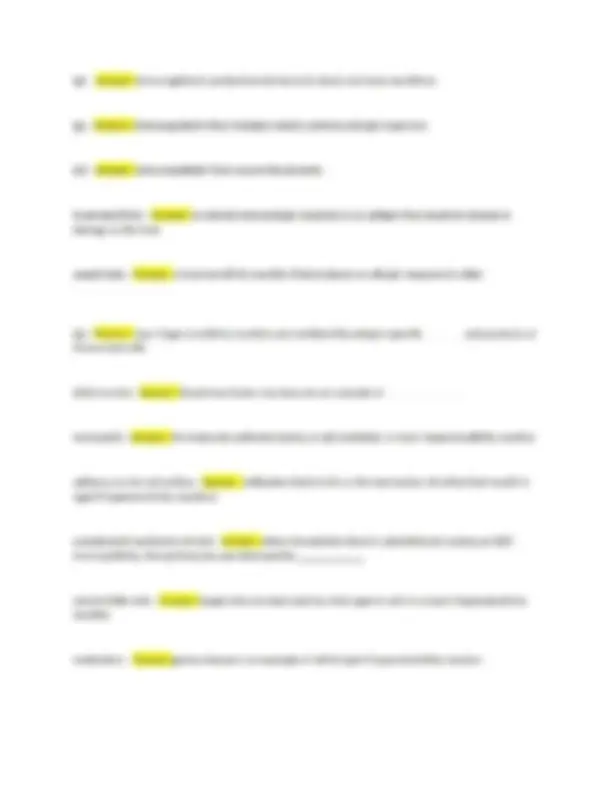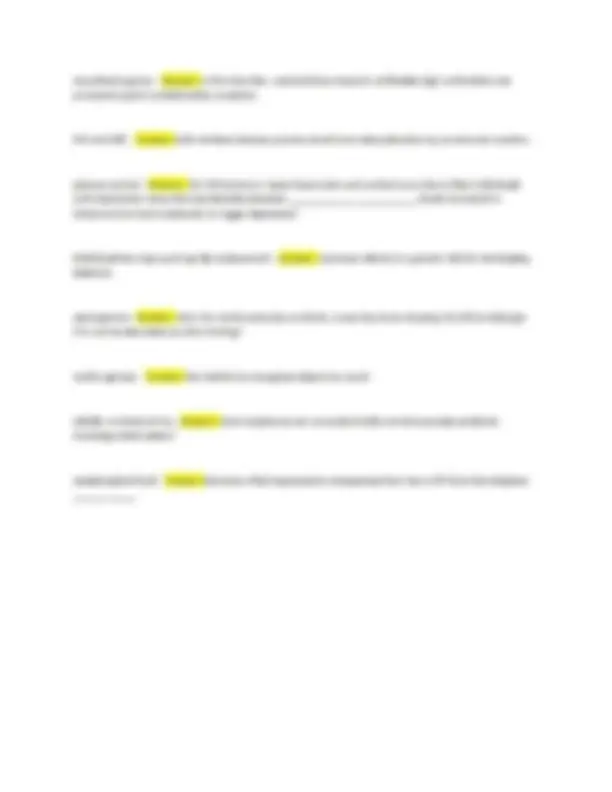Partial preview of the text
Download MARYVILLE PATHO NURS 611 EXAM 2 LATEST QUESTIONS AND VERIFIED SOLUTIONS GRADED A+ and more Exams Pathophysiology in PDF only on Docsity!
MARYVILLE PATHO NURS 611 EXAM 2 LATEST QUESTIONS AND VERIFIED SOLUTIONS GRADED A+ Parasympathetic nervous system - Answer: Body system responsible for conserving energy and body resources Sympathetic nervous system (SNS) - Answer: Body system that responds to stress by preparing the body to defend itself how is blood flow redistributed by the sympathetic nervous system (SNS) - Answer: blood flow to the muscles is increased while blood flow to GI and integumentary is decreased how are primary brain injuries classified - Answer: Focal or diffuse (aka multifocal) focal brain injuries - Answer: specific, grossly observable brain lesions that occur in a precise location Epidural and subdural hemorrhages diffuse brain injuries - Answer: include brain injury due to hypoxia, meningitis, encephalitis, and damage to blood vessels The brain is confined in a limited space so increased pressure can cause collateral dysfunction: Diabetes Insipidus (ADH not secreted thus polyuria) autonomic hyperreflexia - Answer: affected at the t5-t6 level or above; characterized by paroxysmal HIN (up to 300 mmHg systolic), a pounding headache, blurred vision, sweating above the level of the lesion with flushing of the skin, nasal congestion, nausea, piloerection caused by pilomotor spasm, and bradycardia (30-40 beats/min) location of lesions in cases of autonomic hyperreflexia - Answer: individual most likely to be affected have lesions at the T5-T6 level or above sequence of events that lead to hyperreflexia induced bradycardia - Answer: bradycardia (30-40bpm) is asx of hyperreflexia Stimulation of the carotid sinus -->vagus nerve -->sinoatrial (SA) node. The intact ANS reflexively responds with an arteriolar spasm that increases blood pressure. Baroreceptors in the cerebral vessels, the carotid sinus, and the aorta sense the HTN and stimulate the PNS. The heart rate decreases, but the visceral and peripheral vessels do not dilate because efferent impulses cannot pass through the cord Myasthenia Gravis - Answer: a chronic autoimmune disease that is mediated by Ach receptor antibodies that act at the neuromuscular junction. The antibodies prevent normal reception for muscle contraction myasthenia gravis clinical manifestations - Answer: -exertional fatigue and weakness that worsens with activity, improves with rest, and recurs with resumption of activity -a recent history of recurring upper resp tract infections -diplopia, ptosis, and ocular palsies -facial droop and an expressionless face; difficulty chewing and swallowing associated with dietary changes and weight loss; drooling -episodes of choking and aspiration Graves disease - Answer: Graves disease is a result of autoantibodies binding to the TSH receptor sites. This leads to hyperthyroidism acute pain - Answer: an event; cause often known; lasts less than 6 months; sudden onset; clinical signs include increased pulse rate, elevated bp, increased rr, diaphoresis, and dilated pupils; prognosis is usually complete relief low back pain - Answer: most common chronic pain condition chronic pain - Answer: constant situation; cause may be unknown; can be sudden or slow onset; duration is prolonged and persistent; complete relief rarely occurs myofascial pain syndromes - Answer: second most common chronic pain condition resulting from muscle spasms, tenderness and stiffness; ex: myalgia, muscle strain deafferentation pain - Answer: painful condition resulting from damage to peripheral nerve; ex: burn pain caused by cold sleep deprivation - Answer: serious disturbances of the sleep-wake cycle; circadian disruption; can occur in healthy individuals; reduced NK cell activity in healthy individuals conductive hearing loss - Answer: sound is not properly conducted from the outer to inner ear. there is an interference in air conduction that can be caused by foreign body obstructions, tumors, or infection. can be treated and hearing will generally improve symptoms of conductive hearing loss - Answer: diminished hearing, speaking in a SOFT voice, individual can hear better in a noisy environment (paracusia willisiana) causes of conductive hearing loss - Answer: impacted cerumen, foreign bodies, benign tumor of middle ear sensorineural hearing loss - Answer: caused by impairment of the organ of Corti or its central connections. Can possibly be congenital; conditions include noise exposure, aging, meniere disease, ototoxicity presbycusis - Answer: age-related hearing loss usually in high frequencies. progression is slow and onset of symptoms is gradual glaucoma - Answer: leading cause of visual impairment and blindness; family history is a risk factor, can be inheritied open angle - Answer: most common type of glaucoma purpose of the inflammatory process - ‘Answer: the inflammatory process is the body's second line of defense when epithelial barrier is damaged. It's purpose is to limit the extent of damage, pratect against infection, and initiate repair of the damaged tissue what are the 4 cardinal signs of inflammation - Answer: edema, pain, warmth, and redness edema: arterioles near the site of infection or injury constrict briefly. Vasodilation then causes slower blood velocity and increases local blood flow to the injured site. plasma leaks from vessels to tissues causing swelling and blood becomes more viscous warmth/redness: the increased blood flow and increasing concentration of red cells at the site of inflammation. leukocytes adhere to vessel walls what happens if resolution is not possible - Answer: repair takes place instead. This is when extensive damage is present, injury occurs in tissues not capable of regeneration, infection results in abscess or granuloma formation, or fibrin persists in the lesion; scar tissue forms what population is at risk for impaired inflammation and wound healing - Answer: older adults; impaired healing may not be directly associated with again but can be linked to a chronic illness such as heart disease or DM. In addition, anti-inflammatory steroid medications can interfere with the healing process humoral immunity - Answer: antibody circulates in the blood and binds to antigens on infectious agents cellular immunity - Answer: T cells undergo differentiation during an immune response and develop into several subpopulations of cells that react directly with antigen on the surface of infectious agents. some develop into t-cells that can stimulate activities of other leukocytes; some develop into t-cytotoxic cells that attack and kill targets directly target cells for t-cells - Answer: cells infected by a variety of viruses, as well as cells that have become cancerous. active immunity - Answer: acquired; ex-vaccines; produced by an individual either after natural exposure to an antigen or after immunization passive immunity - Answer: does not involve host; ex: breastmilk what are the classes of immunoglobulins - Answer: G-A-M-E IgG, IgA, IgM, IgE IgG - Answer: the most abundant class of innumoglobulins; they constitute 80-85% and account for the most protective activity against infections Maternal IgG crosses into placenta and can be found in blood of the fetus IgA - Answer: found in bodily secretions as dimers anchored together through a J chain and "secretory piece". The secretory piece may function to protect the Ig against degradation by enzymes. These are produced by cells in mucous membranes IgM - Answer: the largest of the immunoglobulins. The FIRST antibody produced during the initial/primary response to antigen. Synthsized early in neonatal life and the synthesis may be increased as a response to infection in utero; it is a pentemere-the initial most important responder to infection IgE - ‘Answer: the least concentrated of the Ig in circulation. Appears to have very specialized functions as a mediator of many common allergic responses and in the defense against parasitic infections Systemis Lupus Erythmatosus (SLE) - Answer: chronic, multisystem, inflammatory disease that is one of the most common, complex, and serious autoimmune disorders increases intracranial pressure - Answer: swelling, commonly seen after TBI can lead to dangerous which can cause collateral dysfunction (Reason to watch output during DI because ADH is not secreted-thus polyuria) hypoxia - Answer: number ‘injury to the brain delerium - Answer: acute, sudden onset, common during hospitalization, lasts hours to weeks, agitation, withdrawn/depression behavior, disoriented thoughts, hallucinations dementia - Answer: chronic, insidious or gradual onset, slow decline, can lasts months to years, attention and orientation are often intact early and impaired late alzheimers - Answer: condition diagnosed by ruling out other possibilities signs and symptoms of stroke (middle cerebral artery) - Answer: hemiplegia orhemiparesis greater in face and arm than leg, contralateral loss in same distribution as motor loss, expressive disorder with anomia, contralateral homonymous hemianoplopia (left vision is intact), cheyne-stokes respirations, occasional mydriasis, little to no sensory loss difference between guillain-barre syndrome and multiple sclerosis - Answer: GBS is caused by a recent bacterial or viral infection; MS is not caused by a previous infection SLE - Answer: a chronic, multisystem, inflammatory disease; it is the most common, complex, and serious of the autoimmune disorders SLE tissue damage - Answer: this is caused by deposition of immune complexes containing antibodies against DNA; deposited in renal tubules, heart, spleen, etc. SLE clinical manifestations - Answer: facial rash confined to the cheeks, photosensitivity, renal disorder, neurologic disorders, hematologic disorders primary immune deficiency - ‘Answer: very rare; most common deficiencies are common variable deficiency, selective IgA deficiency, and IgG subclass deficiency secondary, or acquired, immune and inflammatory deficiencies - Answer: more common than primary deficiencies, complications of other physiologic or pathophysiologic conditions conditions known to be associated with acquired deficiencies - Answer: metabolic disease or genetic syndromes (alcoholic cirrhois, sickle cell, SLE), environmental agents (UV light, ionizing radiation, chronic hypoxia), medical treatments (anesthesia, splenectomy) invasion - Answer: results in direct confrontation with the individual's primary defense mechanism against bacteria evasion - Answer: results in the microorganism transported in the blood to organs (septicemia) exotoxins - Answer: proteins released during bacterial growth; usually enzymes that can damage cell membranes, activate second messengers, and inhibit protein synthesis antitoxins - Answer: exotoxins are immunogenic and elicit the production of antibodies known as endotoxins - Answer: can lead to fatal endotoxic shock (septic shock), which is one of the leading causes of death in ICUs causes of endotoxic shock - Answer: proliferation of gram-negative bacteria; once in the blood, endotoxins cause the release of vasoactive peptides and cytokines, cause decrease oxygen delivery, and produces subsequent cardiovascular shock. syndrome of disseminated intravascular coagulation - Answer: endotoxin can activate the coagulation cascade, leading to cytokines - Answer: endotoxins release by macrophages AIDS - ‘Answer: most notable form of secondary or acquired immune deficiency caused by an infectious agent HIV - Answer: infects and depletes a portion of the immune system, making individuals extremely susceptible to life-threatening infections and malignancies 200cells - Answer: new cases of aids are diagnosed initially by decreased CD4+T-cell numbers at or below general adaptation syndrome - Answer: 1. alarm stage or reaction 2. stage of resistance or adaptation 3. stage of exhaustion low albumin levels - Answer: this will reduce the ability of norepinephrine and epinephrine to circulate appropriately; associated with one's overall health and their ability to adapt alarm stage or reaction of general adaptation syndrome - Answer: the CNS is aroused and the body's defenses are mobilized; one becomes alarmed by a stressor that activates the hypothalamus and sympathetic nervous system resistance or adaptation stage of general adaption syndrome - Answer: individual perceives that they have a choice of either ‘fighting’ or flighting’; this phase begins with the actions of the hormones cortisol, norepinephrine, and epinephrine increased capillary permeability - Answer: causes edema that occurs during the inflammation process because it results in a leakage of plasma from the vessels, causing swelling in the surrounding tissue increased vasodilation - Answer: what process causes heat and redness to occur during the inflammatory process? function of opsonization related to the complement cascade - Answer: tag of pathogenic microorganisms for destruction by neutrophils and macrophages causing vasodilation around the inflamed area - Answer: chemotactic factor affects the inflammatory process by elimination of malignant cells - Answer: role of natural killer cells INF-a - Answer: cytokine produced and released from virally infected host cells in response to viral double-stranded RNA these are secreted in macrophages fever and leukocytosis - Answer: manifestation of systemic inflammation endogenous pyrogens - Answer: the acute inflammatory response is characterized by fever that is produced by the hypothalamus being affected by nonfunctioning scar tissue replaces destroyed tissue - Answer: this occurs during the process of repair after tissue damage opsonization - Answer: during phagocytosis, this step involves phagocytes recognizing and adhering to bacteria fusion during phagocytosis - Answer: during this step of phagocytosis, lysosomal granules enter the phagocyte resolution - Answer: when cellular damage occurs and regeneration is minor with no significant complications, the process of returning the cells to preinjury function is referred to as bradykinins, leukotrienes, and prostaglandins - Answer: these chemical mediators induce pain during an inflammatory process t lymphocytes, b lymphocytes, and macrophages - ‘Answer: an individual's acquired immunity is dependent on the function of these cells lungs, skin, and bladder - Answer: an alder adult is particularly susceptible to infections of these body parts IgA - Answer: immunoglobulin present in blood, saliva, breast milk, and respiratory secretions IgM - Answer: immunoglobulin that indicates a primary immune response; it is the first antibody produced during the initial response to an antigenan IgA - Answer: low levels of this immunoglobulin puts a person at greater risk for developing infections in the mucous membranes IgG - Answer: Evaluation of umbilical cord blood can confirm that which immunoglobulin level is near adult levels infections that focus on epithelial surfaces of the body - Answer: antibodies that are associated with mucosal immune system, such as immunoglobulins, function to prevent this type of infection antigens, antibodies and lympphocyte surface receptors - Answer: molecules that react with components of the adaptive immune system type Ill hypersensitivity reactions - Answer: this type of hypersensitivity reaction is a result of antibodies binding to soluble antigens that were released into body fluids and the immune complexes being deposited in the tissues type IV hypersensitivity - Answer: this type of hypersensitivity reaction causes lymphokine-producing Th1 cells directly attacking and destroying cellular targets raynaud's phenomenon - Answer: type Ill hypersensitivity reaction that is due to immune complexes that are deposited in capillary beds, blocking circulation. Lupus - Answer: tissue damage disease caused by the deposition of circulating immune complexes containing an antibody against the host DNA AandB - Answer: a person with type O blood is likely to have high titers of which anti-antibodies? V- Answer: urticaria is a manifestation of which type of hypersensitivity reaction? Graves disease - Answer: result of autoantibodies binding to TSH receptor sites it contains no antigens - Answer: O blood is considered the universal donor because affecting the receptor for TSH, causing neonatal hyperthyroidism - Answer: graves disease is an autoimmune disease that results in which maternal antibody? t lymphocytes and macrophages - Answer: a positive PPD is the result of and poison ivy, neomycin, nickle, detergents - Answer: potential causes for type IV hypersensitivity bacteria - Answer: phagocytosis involves neutrophils actively attacking, engulfing, and destroying these microorganisms viruses - Answer: what doe natural killer cells actively attack exotoxins - Answer: proteins released during bacteria growth CD4+ Th cells, macrophages, and natural killer cells - Answer: primary target cells of HIV CD4+ Th cells - Answer: AIDS produces a striking decrease in the number of which cells? cortisol - Answer: helper t1 cells suppress this hormone during a stress response hyopalbuminemia - Answer: this causes impaired circulation of epinephrine and norepinephrine during a central stress response endogenous pyrogens - Answer: considering the hypothalamus, a fever is produced by acting directly on the hypothalamus adaptation - Answer: exhaustion occurs if stress continues when which stage of general adaptation syndrome is not successful? alarm stage - Answer: stage of general adaptation syndrome that activates that stimulates the hypothalamus adrenal cortex - Answer: released stress-induced cortisol results in the stimulation of gluoneogenesis by affecting this structure cortisol - Answer: this hormone increases the formation of glucose form amino acids and free fatty acids fight or flight - Answer: signs that a patient is in an adaptive stage of the general adaptation syndrome natural killer cells - Answer: a reduction in these cells appears to correlate with an increased risk for the development of depression nutritional inadequacies - Answer: the elderly are predisposed to malignancy because impairs immunocompetence hypothalamus - Answer: trauma to this would result in uneven expression of mood, unstable blood glucose levels, and poor regulation of body temperature autonomic hyperreflexia - Answer: term used to describe complications that can result from a spinal cord injury above Té6 that is producing paoxysmal hypertension, as well as piloerection and sweating above the SCI autonomic hyperreflexia-induced bradycardia - Answer: this is a result of stimulation of the carotid sinus to the vagus nerve to the SA node hypertension - Answer: this condition poses the highest risk for a CVA anterior cerebral artery - Answer: a right hemisphere embolic CVA has resulted in left-sided paralysis and reduced sensation of the left foot and leg due to this artery being most likely affected by the emboli MS - Answer: the central component of the pathogenic model of this disease is demyelination of nerve fibers in the CNS autonomic hyperreflexia - Answer: a man who sustained a cervical spinal cord injury two days ago suddenly develops sever HTN and bradycardia, he reports severe head pain and blurred vision. the most likely explanation for these sxs is MS - Answer: central nervous system demyelination, possibly from an immunogenetic virus guillain-barre - Answer: this syndrome is preceded by a viral illness myasthenia gravis - Answer: disease that causes muscle weakness myasthenia gravis - Answer: in this disorder, acetylcholine receptor antibodies (IgG antibodies) are produced against acetylcholine receptors MS and GBS - Answer: both of these disease process result from demyelination by an immune reaction plasma cortisol - Answer: the link between major depression and cortisol secretion is that individuals with depression show that persistently elevated levels can result in inflammation that is believed to trigger depression individual two days post-op hip replacement - Answer: someone who is at a greater risk for developing delerium anosognosia - Answer: since his cerebrovascular accident, a man has been denying his left hemiplegia- this can be described as what finding? tactile agnosia - Answer: the inability to recognize objects by touch middle cerebral artery - Answer: most dysphasias are associated with cerebrovascular accidents involving which artery? cerebrospinal fluid - ‘Answer: the body's first response to compensate fora rise in ICP is to first displace 

